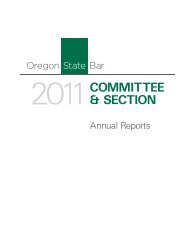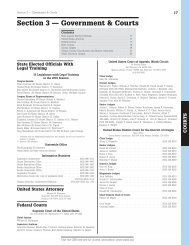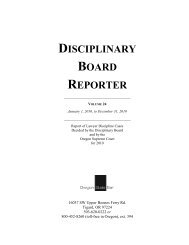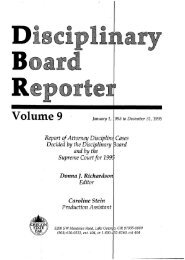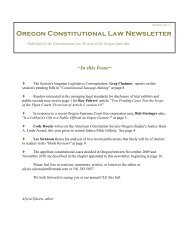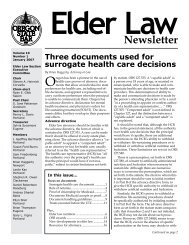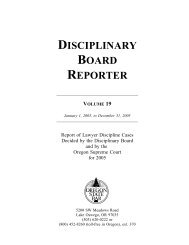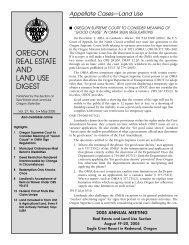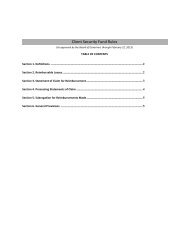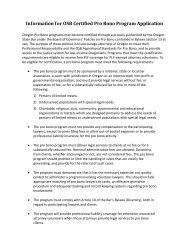February 22, 2013 - Oregon State Bar
February 22, 2013 - Oregon State Bar
February 22, 2013 - Oregon State Bar
You also want an ePaper? Increase the reach of your titles
YUMPU automatically turns print PDFs into web optimized ePapers that Google loves.
<strong>2013</strong> PLF BUDGET, AND <strong>2013</strong> PRIMARY ASSESSMENT PAGE 9<br />
OCTOBER 6, 2012<br />
Primary Program costs was reduced for the <strong>2013</strong> budget. These allocations will again be reviewed<br />
in future budgets.<br />
IV. Actuarial Rate Studv for <strong>2013</strong><br />
The actuaries review claims liabilifies twice a yeaz, at the end of June and December. They also<br />
prepare an annual rate study to assist the Board of Directors in setting the assessment. The attached<br />
rate study focuses on the estimate of the cost of <strong>2013</strong> claims. It relies heavily on the analysis<br />
contained in the actuaries' claim liability study as of June 30, 2012. The methodology used in that<br />
study is discussed by separate memorandum. The rate study only calculates the cost of new <strong>2013</strong><br />
claims. It does not consider adjustments to pending claims, inveshnent results, or administrative<br />
operating costs.<br />
The actuazies estimate the <strong>2013</strong> claim cost per attorney using two different methods. The first<br />
method (shown on E~ibit 1) uses regression analysis to determine the trends in the cost of claims.<br />
Regression analysis is a statistical technique used to fit a straight line to number of points on a<br />
graph. It is very difficult to choose an appropriate trend. Because of the small amount and volatility<br />
of data, different ranges of PLF claim years produce very different trend numbers. The selection of<br />
the starting and ending points is very significant. For the PLF, including a low starting point such as<br />
1987 or a very high point such as 2000 skews the straight line significantly up ar down. Because of<br />
these problems, the actuaries do not favor using this technique to predict future claim costs.<br />
The second method (Exhibit 2) involves selection of expected claim frequency and claim severity<br />
(average cost). Clauns frequency is defined as the number of clauns divided by the number of<br />
covered attorneys. For the indicated amount, the actuaries have used a <strong>2013</strong> claims frequency rate<br />
of 13.5 percent and $20,500 as the average cost per claim (severiTy). The average cost figure has<br />
increase by $500 from last years' study. We feel the $20,500 severity factor is appropriate given the<br />
increases in claim expense severity since 2008.The actuaries' chosen frequency rate is unchanged<br />
from last years' figure of 13.5 percent. We feel that this rate is appropriate given experience in<br />
recent years. The actuaries prefer the result found with this second method. Their indicated average<br />
claim cost is $2,768 per attorney. This amount would only cover the estimated funds needed for<br />
<strong>2013</strong> new claims.<br />
It is necessary to calculate a provision for operating expenses not covered by non-assessment<br />
revenue. As can be seen in the budget, the estimate of non-assessment revenue does not cover<br />
the budget for operating expenses. The <strong>2013</strong> shortfall is about $562 per lawyer assuming 7,104<br />
full-pay lawyers.<br />
The actuaries discuss the possibility of having a margin (additional amount) in the calculated<br />
assessment. On pages 8 and 9 of their report, the actuaries list pros and cons for having a margin in<br />
the assessment.




